More AIS in the USA, the new USCG requirements
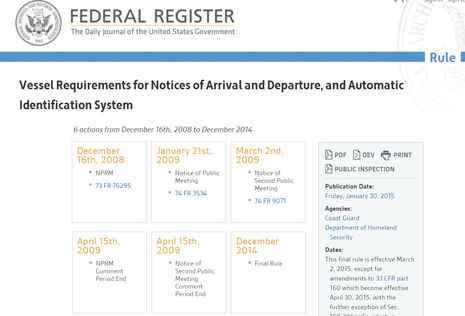 Please credit the U.S. Coast Guard with a sense of humor. The (NOA and) AIS Final Rule may be a dry read, but not last week’s email announcement, which began with the giddy declaration “4,232 days in the making!” I don’t know why the rulemaking process took so long, and it may have been most frustrating for those who do, but I’ll still be glad to have more of the commercial vessels working along our coasts equipped with AIS. It won’t happen fast, though — vessels newly required to carry Class A or B AIS transponders can take until March 2016 to install them — and the number of such vessels seems uncertain…
Please credit the U.S. Coast Guard with a sense of humor. The (NOA and) AIS Final Rule may be a dry read, but not last week’s email announcement, which began with the giddy declaration “4,232 days in the making!” I don’t know why the rulemaking process took so long, and it may have been most frustrating for those who do, but I’ll still be glad to have more of the commercial vessels working along our coasts equipped with AIS. It won’t happen fast, though — vessels newly required to carry Class A or B AIS transponders can take until March 2016 to install them — and the number of such vessels seems uncertain…
When the new requirements were first drafted in 2008, the USCG suggested that Class B transponders might be allowed in some cases to lower costs. In fact, about half of the commercial vessels affected by the requirements will be allowed to use Class B, as illustrated above and at Vesper Marine. Vessels less than 65′ but with 50 or more passengers escaped AIS requirements in the final rule, but when I wrote “USCG AIS mandates, get’er done, please!” in 2010 they only accounted for about 1,000 boats and all the USCG category counts have gone down considerably.
The CG has posted the new “Potentially Effected Population” (sic) count above on their informative AIS FAQ list. Compared to the 2010 count, the total fishing vessels over 65 feet went from over 5,500 to under 3,000, and towing vessels > 26′ & > 600hp from over 4,500 to under 1,500. With the <65′ >50 passenger exclusion, the grand total went from over 17,000 to 5,848. I thought the lower category numbers might be because they eliminated vessels that had already installed AIS voluntarily — like the Maine State Ferries (thank goodness) — but actually it’s because the CG “rid our databases of old and/or duplicate records.”
So I’m going to guess (wildly) that the number of vessels which haven’t already installed AIS but must by 3/1/2016 is about 4,000. That’s a long way from 17,000, but then again, many of the new AIS vessels are underway a lot, voluntary Class B on recreational vessels is increasing rapidly, and the more boats that have it, the more useful it is. It’s a virtuous circle.
If you do have a commercial vessel that may be affected by the new requirements — or if you install electronics on such vessels — perhaps the best breakdown of the “A or B” question is the one above created by SRT and posted at Port Supply along with some good videos about installing (SRT made) Em-Trak Class A and B devices on workboats. Milltech Marine is a great AIS resource, especially for do-it-yourselfers; the expertise of True Heading has come to the USA; and there are reviews and more in Panbo’s AIS section. Now let’s look beyond extended AIS carriage requirements in the USA.
We added a section to 33 CFR part 62 and amended two sections in part 66 to address a comment requesting that we expand AIS carriage to offshore fixed structures. In our NPRM, we encouraged broader use of AIS, but this comment highlighted a particular shortcoming regarding offshore fixed structures. Our proposed rule addressed mobile shipboard devices such as AIS Class A or B, but not offshore structures or AIS Aids to Navigation (AIS AtoN) systems which are best suited for fixed position deployment, such as on offshore oil platforms. Existing AtoN regulations (see 33 CFR 66.01-1 Basic Provisions) bar the use of AIS as a Private Aid to Navigation, and thus preclude the use of an AIS AtoN on certain fixed structures. This prohibition in the current AtoN regulations is inconsistent with our stated objective of broadening the use of AIS. An AIS AtoN would provide position, name, and health status of the aid, such as “on station, watching properly.” These amendments to parts 62 and 66, which allow for enhanced MDA and improved navigation safety, would not require anyone subject to our rule to establish an AIS AtoN, they would merely make that option available.
There’s a whole lot more to the new regulations, and I don’t mean the Notice of Arrivals (NOA) part, which I don’t fully understand and which doesn’t seem relevant to recreational vessels. What struck me in the long, though often elegantly written, Final Rule is the Coast Guard’s broad confidence in the value of AIS both for vessel safety and MDA (Marine Domain Awareness), plus its longterm vision for using it for even more good. I hope the folks who worry about AIS “clutter” and an overburdened system pay attention to where the experts are at after years of experiencing AIS in action.
One example is a modification to the AtoN regs that permits AIS AtoNs — now in wide beta use around the U.S.— to be put up privately (with permission). I highlighted the pertinent Final Rule text above, but then check out the actual “Broader Use of AIS” section for a description of how AIS Application Specific Messaging (ASM) will be used to “provide a more dynamic detail to information that is traditionally conveyed by slower means: chart updates, (e.g., new navigation hazards), printed notices to mariners, navigation publications and directives, meteorological and hydrographic Web sites, and more.” I’m just beginning to understand the ASM aspect of AIS myself, but the USCG is on it, and the possibilities are exciting.
Of course, other people may read this rule in other ways (which may be why it took so long to iron out). In fact, I’ve already heard from a chap who wrote of the rule that he was “surprised that the recreational 65′ vessel was dropped as it was a concern for homeland security and the potential carrying capacity for destructive weapons.” When I replied that I’d never had an inkling that the USCG was planning to mandate AIS on recreational vessels, he couldn’t document his assertion at all, but nonetheless referenced the Rule Note at bottom to conclude that:
Captain of the Port now has the very broad authority to determine who may be required to install AIS…which is a round-about method to addressing to any recreation vessels. You will note it does not specify commercial. This presently satisfies the Homeland security issue and would allow a “quick” fix if desired. (Anticipate the future to require recreational vessels over 65′ to be AIS carriage in certain areas.)
Sheesh! What the Note actually says, I’m pretty sure, is that while the Captain of the Port has always had broad authority to restrict vessel use, he or she can now permit a dubious vessel of any sort to operate if it voluntarily installs AIS. It’s an option, not a mandate, even for those folks who think AIS somehow threatens their liberty. What concerns me much more is what happens if terrorists do strike a soft target with a small vessel, as I once heard a USCG Rear Admiral worry about. But that’s me. What rational conclusions do you draw from the new regs, and what did you find if dug deep?


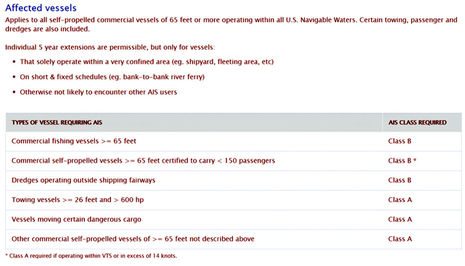
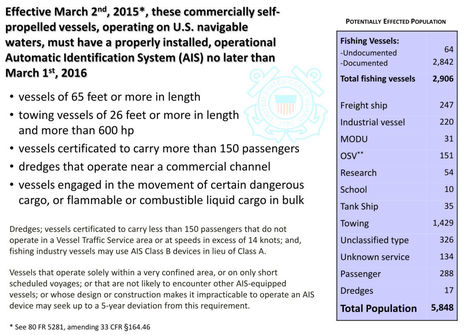
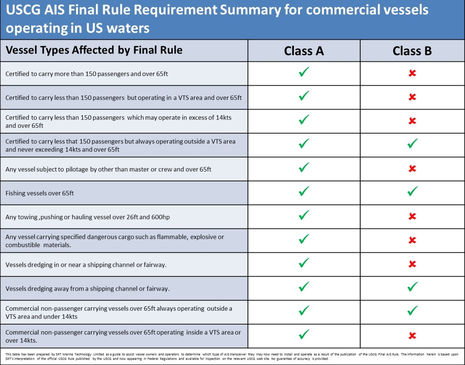
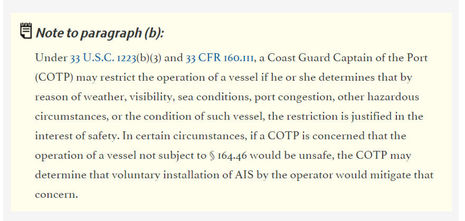

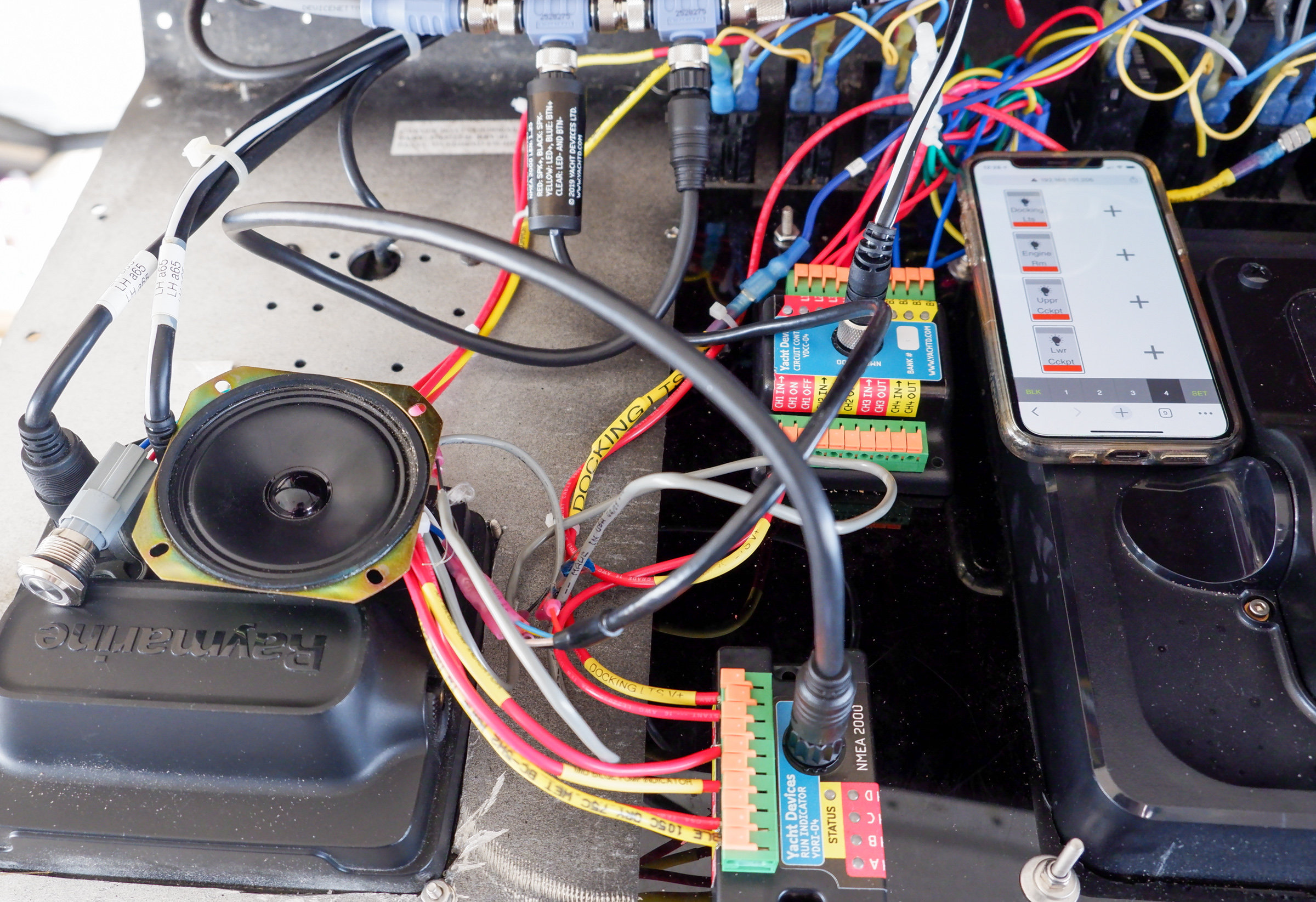









I’m with you, Ben – the more vessels that have it, the better the system works.
I also think that the cost of these devices should also decrease as the population goes up, but perhaps there just aren’t enough boats out there to make a real difference. For sure the technology will continue to progress, however, which should also tend to decrease cost (and size) as well as enhance the feature sets.
For example, I would love to have a low-power AIS to take on my kayak while poking around the bay – my wife could see where I was, and I would be less likely to be run over (kayaks ARE hard to see sometimes). I have an AIS emergency beacon now, but that’s not the same thing.
Hi Hartley. What might really chop AIS Class B transponder cost is if one can be integrated with a VHF radio, and while I used to think that was impossible I’ve recently heard different. It’s not for sure, but may happen.
Meanwhile, SRT makes a completely self-contained Class B that could work great on a kayak. I tried one once and was impressed long battery life and fair range, and I also saw the True Heading version in heavy use during a long race in Sweden:
http://www.trueheading.se/en/aiscarbonidentifier
In Maine many of the lobstermen refer to sea kayaks as “speed bumps” but I think they’re joking 😉
“4,232 days in the making!” — That’s way over 11 years. According to Wikipedia, the first AIS mandate was IMO SOLAS in 2002. The day count must be from the first Federal Regulations for AIS, published in the Federal Register: October 22, 2003.
http://www.uscg.mil/d11/vtssf/aisregs.asp
That document is similar to the new one, so it is interesting to compare them.
At the end of the “get’er done” comments, Ben asks why I thought the new rules were more about security than safety. Yes there is a lot of overlap in those two terms, and no I have no way of even guessing about motives. I can only see what has been written into the new regulations and the comments about those changes which are written in the rule making document.
Scanning through the document, you will see lots about MSA and NOA and NOD. AIS in this context amounts to ship-to-shore communication, which is both safety and security, although the security aspect is the one with the most comment. The benefit is more to the people on shore. The ship-to-ship aspect of AIS is certainly valued, but not commented on much.
From section VI.B.3
MTSA is definitely security. I think of AIS as broadcast which gives the gift of safe navigation to other vessels.
Some vessels will resist until required, but I think that most will want AIS because it offers them some value even if it is not required.
PS. The kayak AIS is a great idea; I wonder when that will be approved.
Hi Ben,
This being the final rule, does it mean that Class E style AIS like Boat Beacon’s (AIS over Mobile Internet) didn’t make the cut? Boat Beacon’s AIS position reception is a great solution for the Kayak user where there is coverage for spotting other boats and ships and family and friends can keep an eye on their position from home too. We have a lot of row boats and canoes using our app for spotting the other boats around them over their short horizon. We are also noticing more and more Coast Guards ( especially the voluntary ones ) using Internet AIS informally both with apps and on web displays at their stations. Folks using Internet AIS apps like Boat Beacon to share position will show up on these if you have an MMSI number .
I wonder how far a class B AIS would be seen from an aerial that close to the water on a kayak with an horizon of only a mile or so at best? Range will be mainly determined by the height of the receiving aerial , so very ‘hit and miss’ on which boats will be able to see you and from how far away. A large ship with an aerial at 30′ would see from about 6 to 7 miles if they keep their CPA alarms on , a fast rib with an aerial on the transom at 4′ ‘ might only see 2 miles away. On small boats I think it is always best to assume you won’t be seen and use AIS receive over VHF or Internet to spot your potential nemesis and then call them up on VHF radio with their ship’s name ( or MMSI) if you think there could be a collision, or call the Coast Guard on your cellphone and ask them to contact the ship.
Thanks, Steve, you bring up some good points.
I don’t think that Internet AIS failed to “make the cut” but I didn’t see it mentioned in the Final Rule’s many pages. Nor have I seen much mention anywhere of the more formal Internet AIS idea known as Class E, though I once thought it would be huge:
https://panbo.com/archives/2012/08/class_e_ais_will_it_be_huge.html
AIS coverage via Internet and cell phone is better over here than it used to be, but I still wish the Dept of Homeland Security would make their coverage available to apps like yours and of course the SmartChart AIS app they actually financed!
Whether privately owned or commercial, airplanes or boats. No vessel, remotely piloted vehicle, or conveyance, should ever be able to travel without proper federal monitoring. If it saves just one life every intrusion in the world is worth it right?
Please, can you guys tighten your nooses just a bit tighter?
Seriously, dude? You think it’s an invasion of privacy for the U.S. government to mandate AIS transceivers on commercial vessels like tugs, fishing, and passenger boats? Just like many, many other countries around the world do?
If you’re worried that the feds are going to mandate AIS on recreational boats, you might want to read this debate:
https://panbo.com/archives/2011/03/ais_a_threat_to_our_liberty.html
Since that 2011 conversation, the USCG has not made a single move to mandate AIS or any other tracking system on pleasure vessels, just like they hadn’t before 2011.
But of course they are watching all kinds of vessels along our coasts, especially ones near “soft targets” like cruise ships or busy waterfronts. They have to.
And I still contend that pleasure vessels who voluntarily identify themselves with AIS are less likely to be boarded or otherwise hassled. It’s certainly seemed true of my boat, though it’s bristling with technology and has been near a lot of sensitive areas since 2011. I haven’t been boarded once. Where’s the noose?
My Gmail/Facebook/LinkedIn accounts are far more invasive than my AIS. My employment and salary records are public record. My employer GIVES my salary and employment info to Equifax (The Workplace verification system is owned by Equifax). Oh and since I have Verizon and AT&T cell services, they know where I am tool.
I am not too worried about AIS.
Anyone with a voluntary AIS installation always has the option of getting a unit with a “silent” switch that turns off the transmitter. I turn mine off sometimes when fishing offshore if I don’t want to attract “new friends” with AIS receivers to the area I am working. Very happy to have the transponder on when running in high traffic areas or in limited visibility.
How many lives does it have to save to make an expense worth it? This is different from Some Dude’s question. He is talking about Big Brother, and we know from experience of the whole range of governments from left to right, up or down, if Big Brother wants to intrude, “saving lives” is just a cover excuse. So back to my question — it’s a question impossible to answer, and any answer would vary from day to day and it would depend on whose lives. It’s all a balance, between security and convenience, between safety and cost. All we can ask is that the rules be reasonable, and in the case of AIS I think they are.
It’s not just the lives that are actually lost that matter. There are also the lives of the survivors and the lives of those who have to search for lost sailors. You may have wondered how much better it would have been for flight 370 to have been using some AIS equivalent.
Here is a sailing example that could be used to encourage AIS and/or EPIRB requirements:
http://www.utsandiego.com/news/2015/feb/21/sailor-richard-byhre-missing-coast-guard/
He didn’t say where he was going, so the CG couldn’t do a search. Another example is the guy just found after being missing at sea for 66 days. He might think an EPIRB is worth it next time.
I hear some places are encouraging hikers to take a selfie of themselves by trail signs and post them online, to make it easier for those searching for them when they go missing. You can wear a helmet on your bike for yourself or do it for your mother, but don’t be surprised if big brother takes an interest.
Is the year of the AIS coming soon to Long Island Sound? AIS is not well adopted in Long Island Sound in the Huntington / Norwalk area. In the past 4 years, only 2-3 recreational boats might be spotted at any given time transmitting, with no obvious increase in adoption year over year (a 10-20% increase in adoption wouldn’t necessarily add a single boat).
On this Memorial day weekend, while traveling from Huntington to Saugatuck, CT at any time 10 recreational boats could be found transmitting simultaneously as counted using a Raymarine AIS650 and a stern rail antenna.
Past informal surveys of local boaters, were a good indication AIS receivers were not being adopted in the area either.
Maybe this year becomes pivotal in the adoption of AIS in our moderately busy waterway.